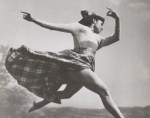
Belén Maya’s Romnia—A Searing Homage to Romany Women
by Jonathan Stein
The mining of identity, often hidden, suppressed or reviled, is a subject for many contemporary artists. But rarely is it realized with the searing power, zest and humor that Belén Maya summoned in Romnia (“women” in Romany). In this extraordinary solo dance-theater work, presented by Drexel’s Westphal College of Media Arts & Design, she embodies multiple female characters representing Romany women.
Maya, who appeared in Carlos Saura’s film Flamenco (1995), is an international star who has played a major role in creating a modern flamenco, stretching and subverting the boundaries and codes of traditional flamenco for more than three decades. She is of Roma descent, an identity she was all but indifferent to during her youth. Feeling, as she described in a Q&A after her performance, that “I was the last one of my race,” she pursued a long process of discovering her lost ancestry, which allowed her to “open up a world of emotions” not available within the restrictions of flamenco. “I feel like Roma, but I’m not living like Roma.”
Roma (or Gypsies) are one of the most persecuted minorities in the history of Europe: slaves in medieval Europe, a condition that lasted until the mid-19th century; forced assimilation; ethnic cleansing; coerced sterilizations; and the Romani genocide (“Porajmos” or “Samudaripen”) during World War II, where up to half of all Roma living in Europe were exterminated by the Nazis.
Maya begins Romnia as an archetypal female figure, rooting her portrayal of various Roma women characters in an ancient past. Dressed in a black top and culottes, Maya shoots her arms like arrows emanating from an iconic vertical torso. Sutra finger gestures and occasional tabla drumbeats suggest the thousand-year origins of the Roma people in northwestern India. Her bursts of percussive footwork ground and empower this figure, as they will the characters to follow.
She transitions to a contemporary Roma and beguilingly sweeps her traditional bata de cola train to become a sensuous muse dancing to the slow sounds of a male vocalist. In stark contrast, her next character crawls out from under the curtain wearing a mishmash costume: a blue bata topped by a red plaid blouse, a tank-top printed with “Lady 33,” and a fanny pack slapped around her middle. She begins as a supplicant entertainer, cunningly soliciting money from the audience before performing a belly dance sparked with flamenco olé gestures that speed up in a frenzy as both an homage and satire of ethnic and popular dance.
The supplicant entertainer’s arms become the forelimbs of a fearful, cringing goat figure cruelly trained to climb a stepladder on two hind feet. This is the Roma street entertainment that Maya observed in Spain.
Maya’s two most potent characters follow. In a slow waltz-like dance, accompanied by clarinet, strings, and a serenading male voice (“Tiganasea” from Romanian composer Nicolae Guță), Maya portrays an abused woman and a not-visible abuser. She gestures to her head and hair, and her head and torso movements become dictated by slight and then more pronounced pulls of her dark hair. With hands covering her face or fixed rigidly behind her head, and with a cold stare or smoldering anger in her face, we read this as the dance of an abused woman. Maya’s flamenco-derived fast percussive footwork and measured finger snaps have unique power in this setting.
To the sounds of a women’s a capella group, Maya assumes wooden clogs and becomes an old woman adrift in a death camp. The music includes the haunting “Samudaripen,” (“they’re all dead”) which Roma sang in the death camps upon the arrival of other Roma by train. This is followed by a Roma hymn (“Elderlezi,” celebrating the return of spring) where Maya, in a blue gown, drapes a broad shawl around herself and swings it as a paseo bullfighter cape in a prideful affirmation of life.
Then it’s pure party time. Maya and a slew of invited audience join in a Balkan folk line dance, which ups the temperature of the room for the final scene. Wearing a flowery white wedding gown with dollar bills pinned onto it, Maya makes her entrance as an inebriated bride, tossing coins into the air with abandon. As her eyes puzzle at her own hand and arm gestures, she does an off-kilter, alcohol-fueled dance. Falling on her rear, seated with legs splayed toward us, she continues her arm and torso movements in a dance to her own amazement and our amusement.
In mining her ancestry with such inventive pathos and humor, Maya may also help us to reimagine our own.
Belén Maya, Romnia, Drexel University, URBN Black Box Theater, Oct. 13 &14. www.drexel.edu/westphal.
By Jonathan Stein
October 20, 2017






.png)


